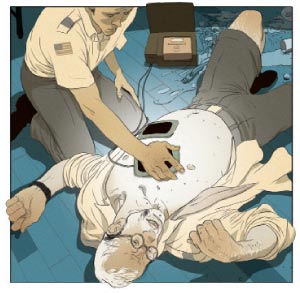
Device for Life
Quick tips for effectively using an AED.
By Josh Piven
Illustration by Frank Stockton
EMERGENCY SITUATION: During a rousing sing-along before dinner, you notice a fellow Scout leader grab his chest and collapse. You spot an automated external defibrillator (AED) on the wall. What do you do?
 SOLUTION: I've said this before: First, don't panic. While it's true that a person undergoing sudden cardiac arrest (SCA) is in need of immediate help—each minute of SCA leads to a 10 percent reduction in survival—you must keep your wits about you.
SOLUTION: I've said this before: First, don't panic. While it's true that a person undergoing sudden cardiac arrest (SCA) is in need of immediate help—each minute of SCA leads to a 10 percent reduction in survival—you must keep your wits about you.
Your first move is the most important: calling 911. Second, check to make sure the victim is nonresponsive by shouting at and shaking the person. Next, check the victim's breathing and pulse. If either is erratic, this is a sign of SCA. But don't waste precious seconds or minutes searching for a pulse. It might be difficult to detect.
Finally, direct a helper to begin CPR while you grab the AED and prepare it. Fortunately, today's AEDs were designed for operation by an untrained responder. They offer audible and visual instructions, and they only produce a potentially life-saving jolt if the machine detects one is needed. Still, you must take several steps before the AED can do its job.
First, turn on the machine and direct others to move the victim to a dry, nonmetallic surface. Next, remove the victim's clothing so the chest is exposed and dry the skin. AED paddles must make good contact.
Before placing the paddles on the victim, check for and remove all metal items touching the skin, including watches, jewelry, or piercings. Next, check for a medical-alert bracelet, pacemaker, or other internal heart defibrillator (you should see the outline of the device under the skin).
Never withhold use of an AED on a person with a pacemaker. But for safety, don't place the pads directly on top of the device. Place the paddles on the victim's chest and check that the wires are connected to the AED.
After making sure no one is touching the victim, press the AED's "analyze" button. The machine will check the victim's heart rhythm and, if a shock is needed, it will tell you when to deliver it. Now you can shout, "Clear!" Standing away from the victim, push the AED's "shock" button. The machine will deliver the necessary jolt—or several, if needed—and direct you to continue with CPR until trained responders arrive.
Be Prepared
- A recent survey showed that 83 percent of council camps are equipped with AEDs, says Richard Bourlon, the BSA's director of Health and Safety. The goal, he says, is 100 percent deployment.
The Value of Training
A Scoutmaster is alive today thanks to his troop—and the guys' training and preparation.
On a warm night in July 2007 at Woodruff Scout Reservation in Georgia, Jose Lepervanche walked up a hill to his campsite. Soon after, while in the middle of a conversation with his troop, he fell over onto a table. He had no pulse and was not breathing. He was experiencing sudden cardiac arrest.
Right away, five Scout leaders took turns performing CPR until the camp's emergency medical technician, Brian Hendrick, arrived with an AED and began administering shocks to Jose's heart. A group of older Scouts lined the road with flashlights to guide the ambulance up the steep hill. Others worked to keep the younger Scouts calm. Jose is alive today because his troop was calm and prepared.
Josh Piven is the co-author of the Worst-Case Scenario Handbook series. Visit his Web site at joshpiven.net.